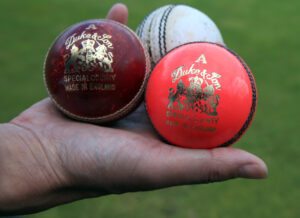The divisive debate that surrounds cricket’s famous balls continues.
Introduced in a trial run last season, it was hoped the Kookaburra ball would lead to an improvement in the England team’s fortunes overseas.
Three rounds into the trial this season, we have seen a feast of runs while bowlers toiled for little reward.
The player that summarised this up the most was Durham’s Matthew Potts against Warwickshire.
With the ball, Potts went wicketless for 106 runs in Warwickshire but made 149 with the bat.
What is this trial and what has the first three rounds of action shown us?
In 2022, the ECB opted to trial the Kookaburra ball in the 2023 and 2024 County Championship seasons.
Used overseas, the Kookaburra swings far less than the Dukes ball that is used in England.
Additionally, it was hoped that this would lead to more of a utilisation for spin bowlers who bowled 22% of the overs in England before the trial of the Kookaburra ball.
Statistically in the first two rounds, we have seen success from a batting perspective.
The batting average this month has been 44.49, the highest figure in a month since 1938.
But has this improved the quality of cricket?

We’ve seen declarations this year for 698/3 by Warwickshire and 649/9 by Sussex as well as teams skittled over for just over 100 like Lancashire most recently.
Last Friday marked the return of the Dukes ball. In its first day of action the ball took 72 wickets across the day.
England Men’s team director Rob Key has arguably been the Kookaburra ball’s biggest advocate.
Key spoke to the Guardian after the the second round of the County Championship.
“I think it’s been fantastic,” said Key. “I would use the Kookaburra all the time. English cricket would be much better off for it.”
“The pitches are slow this time of year but watching medium pacers is a waste of time. Teams need to find quicker bowlers.”
Key also highlighted Warwickshire’s game vs Durham as an example of the benefit to England internationals.
“That looked a turgid [slow] pitch but [Potts and Carse] are much better equipped for international cricket…The best bowlers come from the flattest pitches.”
However, there has been vocal opposition after these first two rounds.
Surrey Director of Cricket Alec Stewart called the implementation of the Kookaburra “the worst decision ever”.
"I just don't understand it at all, I think it's the worst decision ever"
Safe to say, Alec Stewart is NOT a fan of using the Kookaburra ball in English cricket… 😅 pic.twitter.com/cWwgQlNWoP
— Sky Sports Cricket (@SkyCricket) March 26, 2024
Speaking on the Sky Sports Cricket Podcast, the former England Wicketkeeper said: “Playing against a Kookaburra in England is nothing like playing against a Kookaburra in Australia or South Africa.”
Stewart also predicted a change in the pitches due to the Kookaburra.
“Because the Kookaburra does nothing, if anything, I reckon sides will leave more grass on the pitch to try and force a result.”
One factor that will have played a factor in the first two rounds was the weather.
Even on a fine day, the Kookaburra goes softer than the Dukes ball.
And with the weather we have had recently that has delayed games or caused them to be abandoned, this may have had some effect.
With two further rounds of trials planned for September, no doubt this debate will continue long into the English Summer.
Especially with tours of Pakistan, the West Indies and New Zealand this Winter, and an important Ashes Series ‘down under’ in 2025/2026 on the horizon.
Images used under agreed Alamy license.














